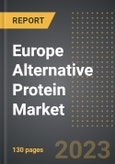The European Alternative Protein market was valued at USD 1906.4 Million in 2021 and expected to grow at a CAGR of 20.2% during the forecast period of 2023-2028. The market will account for two-thirds of worldwide consumption by 2035, driven by a big and expanding population that is consuming more proteins as it becomes wealthier.
The primary factors influencing the consumption of alternative protein products in Europe are the environmental and health benefits. Customers are actively looking for sustainability and health-related qualities, boosting their intake of plant-based proteins. The alternative protein market is most developed in Europe, where a number of these products have been available on grocery store shelves for some time. The highest GDP per person in the world will continue to be in Europe. Due to the climate and communities that value their health, alternative protein adoption is expected to rise quickly.
Governments are funding research and innovation projects all around Europe to accelerate the diversification of proteins. Increasing protein self-sufficiency, dismantling unsustainable supply chains, and diversifying protein sources and end products are all part of Europe's efforts to change its food systems.
The willingness of consumers to adopt these alternatives into their preferred diets is a key factor in the expansion of the alternative-protein business. Moreover, a growing percentage of the total protein will be made up of alternative proteins. The need for alternative proteins is being driven by a number of strong megatrends, including environmental protection, factory farming ethics, and health concerns.
Investors have a wide range of options in the alternative protein market since these proteins are entering a segment of the food industry that is particularly resistant to recession and cyclicality, making them a solid hedge against any hidden competitors that might have an impact on the entire economy.
Key Target Audience:
- Alternative Protein Producers/ Vendors
- Supply chain Distributors
- Consulting and Advisory Firms
- Research and Development Organizations
- Government and Regulatory Authorities
Scope of the Report
- The report analyses the Alternative Protein Market by Value (USD Million)
- The report presents the analysis of Alternative Protein market for the historical period of 2018-2021, the base year 2022 and the forecast period of 2023-2028
- The report analyses the Alternative Protein Market by Product Type (Plant Protein, Insect Protein, Microbial Protein)
- The report analyses the Alternative Protein Market by Application (Food & Beverages, Animal Feed and Pet Food, Nutraceuticals)
- The report analyses the Alternative Protein Market by Sales Channel (E-commerce Channels, Convenience Store, Supermarket/Hypermarket)
- The Europe Alternative Protein Market has been analysed by countries (United Kingdom, Germany, France, Italy)
- The key insights of the report have been presented through the frameworks of SWOT and Porter’s Five Forces Analysis. Also, the attractiveness of the market has been presented by region, by Product Type, by Application, by Sales Channel -
- Also, the major opportunities, trends, drivers and challenges of the industry has been analysed in the report
- The report tracks competitive developments, strategies, mergers and acquisitions and new product development. The companies analysed in the report include Archer-Daniels-Midland Company Kerry Group plc, Sudzucker AG, Glanbia PLC, Royal FrieslandCampina N.V., Arla Foods amba, Nomad Foods, Royal DSM N.V., Ingredion Incorporated, Cargill, Incorporated
Table of Contents
Table Information
| Report Attribute | Details |
|---|---|
| No. of Pages | 130 |
| Published | February 2023 |
| Forecast Period | 2023 - 2028 |
| Estimated Market Value ( USD | $ 2.45 Billion |
| Forecasted Market Value ( USD | $ 6.14 Billion |
| Compound Annual Growth Rate | 20.1% |
| Regions Covered | Europe |









